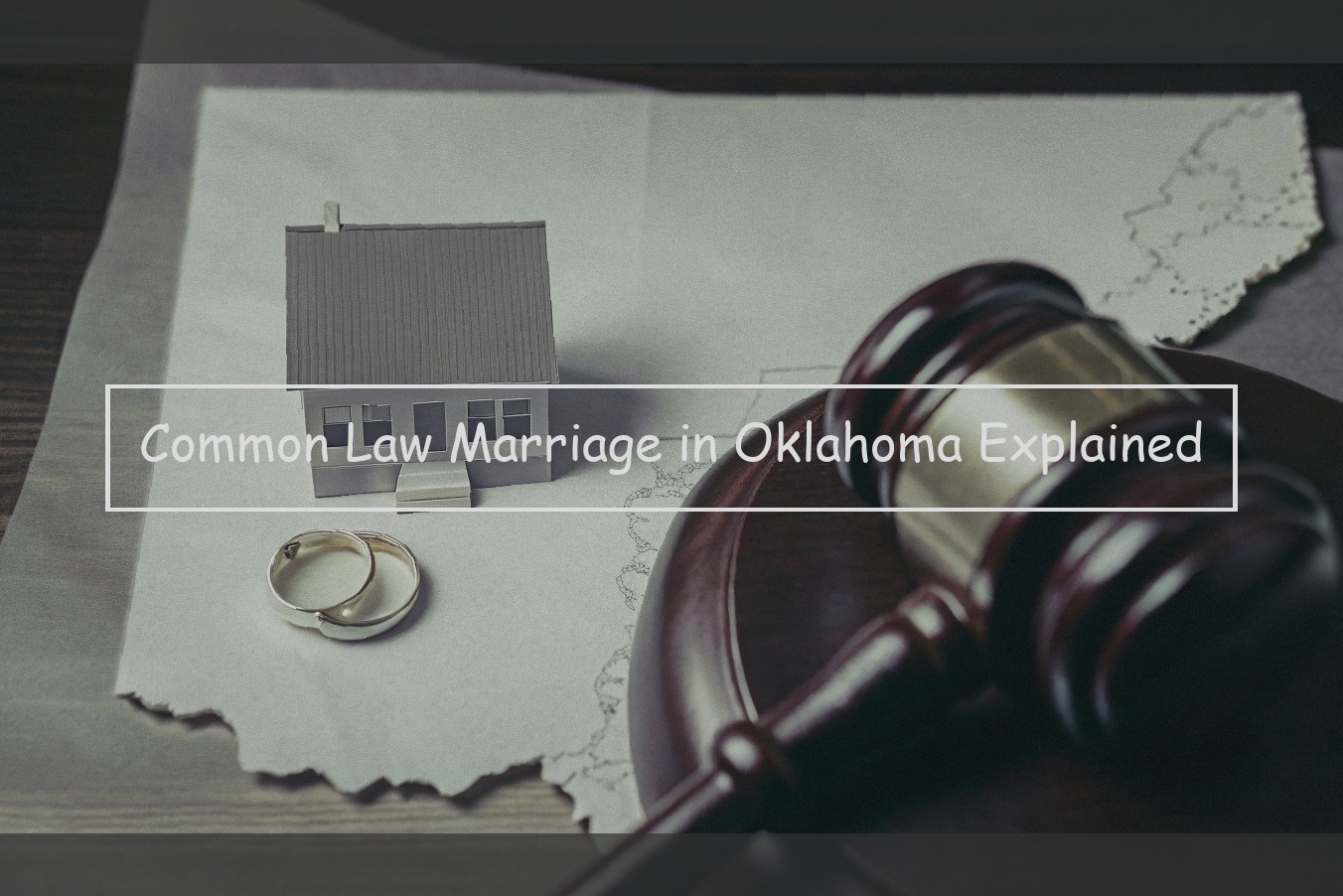What is Common Law Marriage
Generally, a common law marriage is a non-ceremonial union between a man and woman that has the forces of a "registered" matrimonial relationship. The Court in Rader v. Rader, 1942 OK 255, 124 P.2d 469, 193 Okla. 589, adopted the common law of England which was "imported" to Oklahoma because of the absence of legislative action. All of the requirements of a ceremonial marriage are present in a common law marriage except that of a solemnization ceremony, or "the doing of some act or acts evidencing that the parties consider themselves husband and wife."
Common law marriages should not be confused with "void" or "invalid" marriages. A marriage is deemed "void" when a court has declared it invalid. A "void" marriage was invalid from the moment it was celebrated. A common law marriage, on the other hand, is considered valid until a court has declared it invalid or "void . "
The basic requirement for a common law marriage is that the parties must have the capacity to enter into a valid ceremonial marriage. Although the parties must "as a result of their words and conduct, hold themselves out publicly" as husband and wife, no single act is required to accomplish this in order to be valid at common law. Rather, it is for the courts to decide from the totality of the circumstances in each case whether the evidence presents a clear intention to enter the status of husband and wife.
In addition to the intent, the parties "must, with knowledge of the facts, treat each other in all respects as husband and wife." Neither cohabitation nor procreation is necessary to establish a common law marriage at all times but is relevant to show that a common law marriage existed. The general rule is that there must be cohabitation at some point for the creation of a common law marriage. However, the absence of cohabitation does not necessarily defeat a claim to such a marriage.

Is Common Law Marriage Legal in Oklahoma
While there is a common misconception that common law marriages can be entered in Oklahoma, such is not the case. The Supreme Court of Oklahoma has held that a common law marriage must be entered into prior to November 1, 1998 in order to be considered valid in Oklahoma.
The Oklahoma Family Law Code (namely 43 O.S. § 16) lists the elements necessary to create a common law marriage, which are:
- (1) Capacity to enter into marriage
- (2) Mutual consent
- (3) In a permanent relationship
- (4) A proper purpose, and
- (5) Co-habitation subsequent to the removal of any former spouse or partner.
96 P.3d 536, 539 (2004).
With the 2015 enactment of the Oklahoma Marriage Equality Act, the Oklahoma Family Law Code (also known as the Oklahoma Marriage Act) now defines marriage as follows:
Marriage is a personal relation, arising out of a civil contract, to which the consent of parties competent to contract is necessary. A marriage may be solemnized only in accordance with compliance within the jurisdictions requirements set forth, and upon issuance of a marriage license issued in accordance with the provisions of Title 43 of the Oklahoma Statutes. Marriage and related words and phrases as used in other sections of law or code of the state of Oklahoma shall have the same meaning and interpretation as set forth in Section 1 of this title.
If you are in a situation where you believe that you have a common law spouse, it is in your best interest to seek legal advice from an attorney knowledgeable in this area of law.
How to Prove a Common Law Marriage
A common law marriage in Oklahoma is not formed unless the couple agrees that they are married and holds themselves out to the public as being married. Neither is there a set period of time or the cohabitation of the parties sufficient to itself establish a common law marriage. To establish such a relationship, the parties must prove: The relationship cannot be based on an implied agreement but a clear and unambiguous agreement to marry on the part of both. Even if the parties have a mutual agreement to be married, and hold themselves out to the public as husband and wife, their marital status may not be recognized until they actually cohabit together. With regard to cohabitation, the Oklahoma Supreme Court has ruled that cohabitation does not mean continual and uninterrupted cohabitation. Instead, evidence demonstrating living together for any substantial period of time immediately before the suit in question is sufficient. The Oklahoma Supreme Court has ruled that separate residences do not destroy the marriage even if the separation is intended to be permanent, but if the joint residence is abandoned in favor of a permanent separation, the cohabitation requirement is destroyed.
Common Law Spouse’s Rights and Duties
The Oklahoma Supreme Court ruled in 1991 that the rights of common law spouses were not uniform under Oklahoma law. "Sec. J-A: The rights of a putative common-law spouse (whether married legally or as a result of the common-law situation) should be no different than those of marital spouses."
So, common law spouses are treated the same as regular spouses. This means that common law spouses in Oklahoma have the right to property obtained during the course of the marriage and owe the same duty to support as a legally married spouse.
In Oklahoma, all property obtained during the course of a marriage is deemed joint and marital property. This includes property owned by one party prior to marriage and all salaries, wages, bonuses, commissions, savings and business earnings. Property that a common law spouse owned prior to the marriage remains the separate property of the owning spouse upon termination of the marriage, according to Oklahoma Supreme Court Precedential Decision No. 95-1. Also, debt that accrued prior to the marriage will not be considered joint debt, leaving the individual spouse with the debt responsible for paying it upon dissolution of the marriage.
A common law spouse has the same duty to support as a regular spouse, which means that if one spouse is authorized to act on behalf of the other, that spouse cannot decide to act independently without the consent of the other spouse. This principle is also known as agency.
Oklahoma law generally requires the court to grant a divorce and make a decree one month after the divorce petition is filed, but if the common law marriage continued for less than 10 years, the court may deny a divorce and instead grant an annulment.
A Common Law Marriage Divorce in Oklahoma
A valid common law marriage is dissolved in Oklahoma just like a traditional marriage. The courts may divide up property, retirement accounts, income tax claims, debt, and other interests acquired during the marriage, as is done in regular divorce cases, as well as decide on custody and child support in the case of children. When someone files for divorce or for dissolution of the marriage, all the usual requirements are the same, and a final decree will be issued within three months if no one responds to the decree and six months if there are objections. The court is equally likely to grant a divorce without a contested hearing if it is not contested. If it is contested, a hearing is simply held . In a contested dissolution of a common law marriage, the party objecting to the proceeding must simply move to vacate the separate property order if one is entered. All property is community property, and nothing can be acquired during the marriage by either party that cannot be fully disposed of by the other. Even if an asset was acquired by inheritance during the marriage, it is subject to division. This means that the property or income earned by one spouse may be completely taken by the other in the event of a divorce. In terms of rights to health care and employment retirement, spouses also have exactly the same rights whether or not the marriage is a formal or "common law" one.
Problems with a Common Law Marriage
Easier said than done. On the one hand, proving that a common law marriage existed may be difficult. Most people who contract a common law marriage do not keep a paper trail that evidences the marriage. For instance, many do not obtain a certificate of marriage, do not change their last name, do not file joint tax returns and do not use the same health insurance. Yet, it must be proven to all applicable legal standards that the parties were married. Thus, one of the hardest things about a common law marriage is proving the existence and terms of the marriage. This is especially true if the marriage is dissolved by the death of one of the parties. Sometimes a decedent will leave behind a post-nuptial agreement that addresses the issues that arise upon his or her divorce from a legally-married spouse. However, a post-nuptial agreement dealing with the purported common law marriage may place the common law spouse at a disadvantage.
On the other hand, if the marriage is dissolved during the lifetime of one or both parties, the division of property may be extremely difficult. During a lifetime, one party may come to see the relationship more as a live-in roommate situation instead of a marriage. However, because a common law marriage means that the marriage is considered valid, court order and legal proceeding may be necessary to divide the assets.
Another challenge comes in the form of unwanted inheritance, either to or from a so-called common law spouse. Oklahoma recognizes "meretricious cohabitation," which is essentially "marriage-like" living arrangements. If the parties have not entered into a valid common law marriage, they also have not entered into a formal one. Either party may have later died. The remaining party may see the dissolution of the relationship as a dissolution of the common law marriage — even if it was not. When that party dies and no will exists or when the will is ambiguous, the deceased party’s estate may end up holding property that belonged to the other party, solely for the other party’s benefit. If those assets were retained, the remaining party may have an unexpected windfall.
Common Law Marriage FAQ
1. What is common law marriage in Oklahoma?
Common law marriage in Oklahoma was a method by which married couples could have valid marriages without a marriage license, involving the intention to be married and living together as a married couple. Common law marriage is no longer allowed in Oklahoma, meaning that many Oklahomans who believe they may be in a common law marriage may no longer have a valid one.
2. How do I know if I was married under common law in Oklahoma?
There are a variety of factors that can determine whether or not your common law marriage existed, such as the length of your relationship, how long your relationship has lasted, the living situation of the couple, and whether or not a marriage license is involved . To be sure, consult with an attorney about the facts of your situation.
3. Can I get alimony in Oklahoma if I was in a common law marriage?
Although common law marriage is no longer recognized by Oklahoma, spousal support can enter into play according to the length of your marriage, whether you share children, and your economic and financial stability in terms of your earning power and job performance. Consult with an attorney about the facts of your case.



